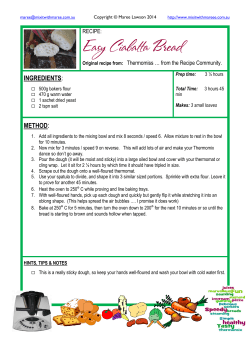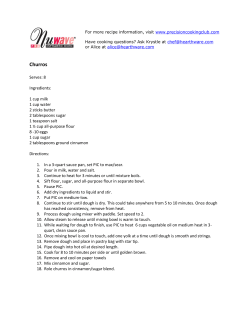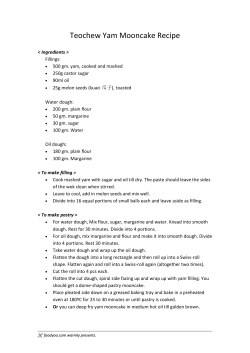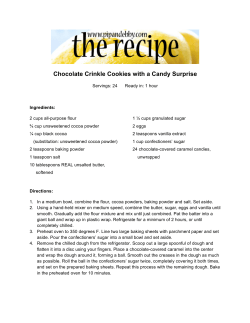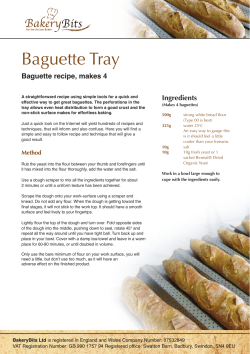
Document 192931
page 1 Technical Notes: Vol. 1, Issue 1 How to Make Reliable Prediction of Wheat Flour Functionality? The major functional component of functionality test method should be able to wheat flour conferring viscoelastic properties interpret are the known properties of to the dough and thus enabling its utilization monomeric and polymeric proteins of flours in a wide array of food products is gluten. and the critical role of different protein Gluten is a complex mixture of proteins which subunits in the development of dough. The vary in their proportions, structure and success of Brabender® rheological properties to impart different functional instruments for test methods lies in the attributes to wheat flours. Gluten is essentially remarkable interpretation of the key comprised of two protein fractions namely phenomena leading to the formation of gluten gliadins (alcohol soluble) and glutenins (acid and their interaction with other flour/ or alkali soluble). Gliadins impart extensibility ingredient components such as the observed while glutenins are responsible for elasticity in maximum resistance during mixing, stability, the wheat dough. Quantity and composition of dough development time, credible polymeric glutenin storage proteins are mechanisms of elasticity that make the generally considered to be the primary judgment of flour quality a simple picture to contributors to variations in functional analyze. The automated data acquisition properties among wheat cultivars. There are programs extract the relevant facts and present various disulfide bonds, electrostatic and the data in a simplified version that enable hydrophobic interactions in the flour system understanding of the fl our functionality at all that stabilize the structure of gluten and play a levels. vital role in determining the functiona l properties of the dough. Prediction of flour functionality is Almost all of the flour utilization in the industry involves mixing of the flour into dough at a certain level. The nature of gluten important at all levels of the wheat process macropolymer changes throughout the dough chain, beginning with breeders fo llowed by mixing process and these changes are also millers, product developers and ending with impacted by other flour components which consumers. The key factors that a flour interact with flour proteins. The chemical Technical Notes: Vol. 1, Issue 1 page 2 predictive techniques based on the principles ingredient matrices can provide a fair view of of swelling of glutenin fractions and/or their trends, ranks and cut-off values, thus sedimentation values cannot bring out the simplifying the process of new product motion depiction of dough development as do development- saving labor, cost and time. the rheological instruments. The results of Rheological instruments testing the these chemical predictive methods lead only to quality of dough and gluten basical ly fall in a secondary indication of the dough quality. three main groups. Those that show the effect Similarly, the reliability of methods based on of water on dough consistency, those used to extraction of gluten or its fractions will stretch a mass of dough to measure its depend on the extent to which convincing resistance and extensibility until the strand evidence of the extracted protein fraction breaks and finally, those involving heat which reflects the properties of the same fraction measure the slackening of a dough or batter observed in the native dough system. and hence give a measure of the enzyme Rheological properties of wheat dough activity of the dough. Brabender® depend largely on the structure of gluten. rheological instruments have a long history Brabender® rheological instruments of serving the food industry with an describe the gluten polymer behavior in its established research portfolio. Rheological primary form as it would perform later in the measurements of each batch in the production product development applications. The line are very useful and make online and in- ultimate test of flour quality is evaluation of time process adjustments possible with the its ability to make good quality end products. fo llowing instruments: The product development applications usually involve the impact of additions of different The Farinograph® is one of the most ingredients on the properties of dough to be commonly used flour quality tests in the observed. The automated data acquisition world. The results are used to estimate the systems associated with the instruments trace amount of water required to make dough, the curves right from the beginning of evaluate the effects of ingredients on mixing incorporation of different ingredients, thus properties, flour blending requirements, clearly showing the cause-effect relationships tolerance to over-mixing, check flour of the interaction of the additives with the uniformity and dough consistency during flour components and their impact on dough production. Farinograph® results are also properties during the entire course of mixing. useful for predicting finished product texture Rheological test of different levels of flour- characteristics. For example, strong dough page 3 Technical Notes: Vol. 1, Issue 1 mixing properties are related to firm product The GlutoPeak is a rapid shear based method texture. that uses small sample size and demonstrates the di fferences in gluten protein characteristics. The GlutoPeak has wide array of appl ications covering breeders, millers and product manufacturers. lt can sensitively segregate early generation wheat lines, predict fl our quality, optimize milling operations, observe effect of new ingredients on the gluten aggregation and strength, rapidly test new formulations and accelerate innovative The Extensograph® is a suitable instrument new product development. for measuring the stretching properties of dough to make reliable statements about the baking behavior of the wheat dough in practical industrial applications and in research. Results from the Extensograph® test are useful in determining the gluten strength, bread-making characteristics of flour, effect of fermentation time and additives on dough performance. The Glutograph® instrument enables reliable, objective, and reproducible measurement of the stretching and elastic properties ofwashed wet gluten and dry gluten. The Glutograph® can test flour quality with regard to its suitability for noodle production, recognition of drying and heat damage of flour and dry Technical Notes: Vol. 1, Issue 1 page 4 gluten, and surveillance of the quality of dough during production. Accurate prediction of dough rheology can provide many benefits to the baking industry for satisfying consumer demands. These instruments can be combined with the range of other quality analytical instruments available at Brabender® for a complete solution for your quality chain covering different stages of production. The Viscograph®-E measures the gelatinization properties of flour and native or modified starch, enzyme activity in flour (e.g. sprout), adjust the diastatic activity by adding enzymes (e.g. malt flour), influence of extrusion conditions onto the extruded product. Peak viscosity helps to predict flour quality to produce noodles with better texture characteristics.
© Copyright 2025

